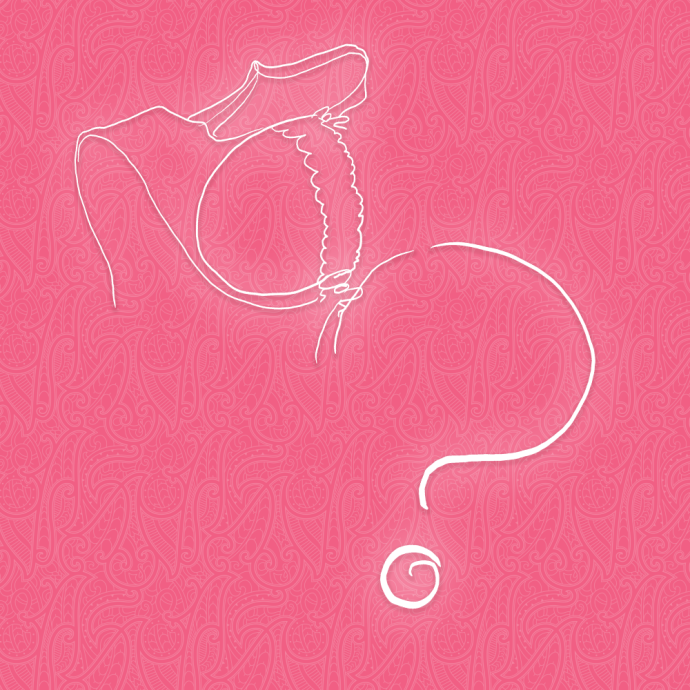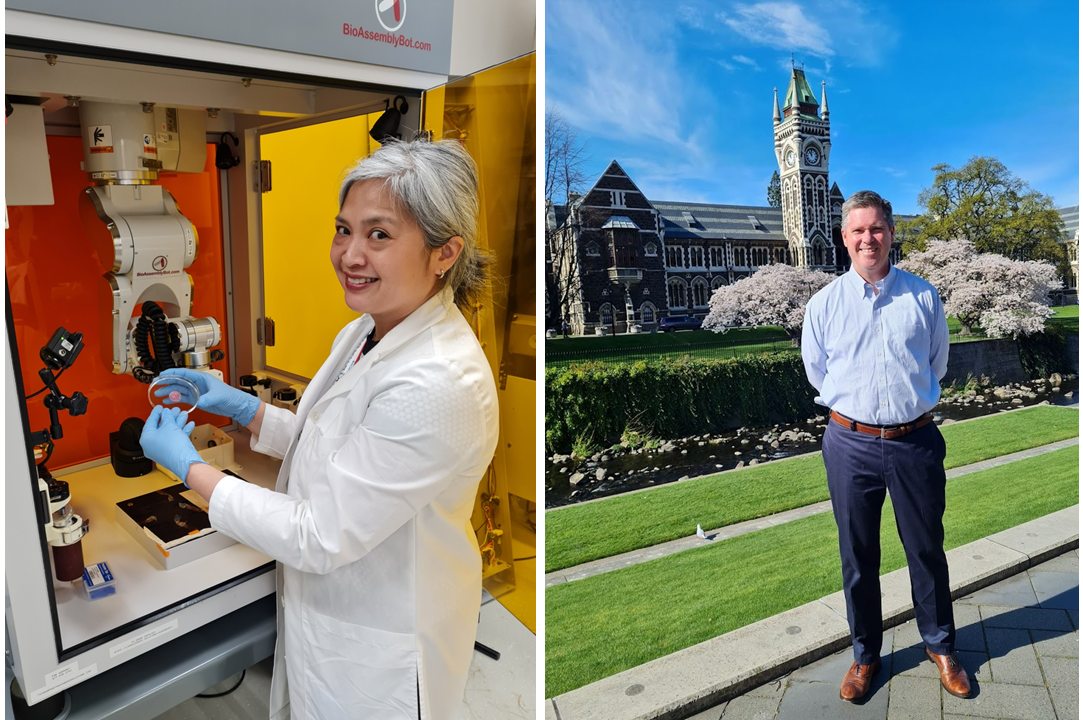Research
Published 21 October 2025Restoring a part of me: 3D bioprinted nipples for breast cancer survivors

Treatment for breast cancer can involve losing some of your most intimate body parts. But what if we could print new ones?
With the help of a Catalyst: Seeding grant, Associate Professor Jaydee Cabral and Professor John Fisher are hoping to fill an area of clinical need by printing biocompatible nipples. We sat down with both researchers to discuss their innovative approach to nipple reconstruction.
We also spoke to three wāhine toa who have lost nipples during breast-conserving surgery or mastectomies as part of their treatment for breast cancer. Laura Roberts, Brenda Little and Dee Wanger opened up about their experiences of losing a nipple and shared their thoughts on this exciting new line of research.
The challenges of losing and replacing nipples
“You have surgery and treatment and then people think you are all OK, all done with cancer. But it’s a grieving process… it would be nice for people to understand the mental, emotional side of it a bit more. Although I look well and am physically doing well, it’s an ongoing mind game.” (Laura)
One in every nine women in Aotearoa face a breast cancer diagnosis at some point during their lives. Brenda remembers the immediate aftermath of her diagnosis with painful clarity. The size and placement of her tumour meant that she was one of the ‘lucky’ women eligible for a breast-conserving surgery (where only part of the breast would be removed) rather than a full mastectomy. When she sat down with the surgeon, though, he dropped a bombshell; her nipple would have to go. It was stated matter-of-factly but felt like a “massive assault.”
Breast reconstruction can be a saving grace for women mourning the loss or alteration of their breast(s), but reconstructing the nipple-areolar complex (NAC) ― the part that includes the nipple and areola ― remains challenging. Surgically-reconstructed nipples tend to lose their shape over time, and non-surgical options (such as nipple tattoos and prosthetic nipples) have their own drawbacks in terms of realism. Could there be a better option for those looking to replace what they’ve lost?
Could 3D bioprinting be the answer?
“This challenge fits well with what my lab does best ― assembling biological materials in a precise way.” (Professor John Fisher)
Associate Professor Jaydee Cabral (Ōtakou Whakaihu Waka the University of Otago) and Professor John Fisher (University of Maryland) are hoping to create a better nipple replacement as part of their joint Catalyst: Seeding grant. Their approach draws on both researchers’ extensive experience in bioprinting and tissue engineering.
The plan is to print NAC constructs using a specific kind of ‘bioink’, a cell-friendly material that mimics the cell’s natural environment. The bioink used in this project was developed in John’s lab and is made up of two complementary components; a synthetic material, which acts as a rigid scaffold to prevent the NAC from losing its shape, and a natural, degradable material that promotes tissue growth. The patient’s own cells are embedded in the printed constructs, where they can divide and grow to generate essential tissues.

Associate Professor Jaydee Cabral holding a bioprinted NAC construct (left) and Professor John Fisher during a visit to Ōtepoti Dunedin (right) (photos supplied)
Printing the constructs is only part of the challenge. The team must also keep the cells within alive until they’re matured and are ready to be attached to the patient. John’s PhD student, Amal Shabbazz, has developed a custom, 3D-printed bioreactor just for this purpose. The bioreactor acts like the circulatory system in the body, delivering a constant flow of nutrients to the construct and removing any waste products.
Of course, this only works well for cells on the outside of the construct, which are directly exposed to the flowing media. To nourish the innermost cells, Jaydee’s MSc student Emma Managh is working on promoting the growth of blood vessels within NAC constructs. Solving this problem would represent a major advancement in the field of tissue engineering and potentially open up avenues to print thicker and more complex tissues.
It's a lot of work for such a small piece of tissue. “I had no idea how complicated nipples were until I started working on this project”, admits Jaydee. Luckily, growing blood vessels is right in her wheelhouse; vascularisation has been a key focus of her previous research on bioprinted wound dressings. With her and John’s expertise combined, they are in a good position to break new ground on this challenging problem.
If it looks like a nipple...
“I got given the choice to have my nipple reconstructed, but because it was going to be sticking out [like a] stiff nipple I didn’t want that. If there was ever a nipple reconstruction where it could change from soft to firm, I might consider the surgery.” (Laura)
The development of realistic-looking nipple implants is a huge step forwards for women concerned about the aesthetics of nipple loss, but can bioprinted NACs recreate other features of natural nipples?
Currently, the team is focused on creating and commercialising a relatively simple, low-cost NAC construct with a suitable aesthetic and long-term shape retention. However, they have high hopes for integrating more complex features into future implants. For example, Amal is currently working on adding smooth muscle cells into bioprinted NACs, with the eventual aim of creating implants capable of contraction like a natural nipple.
The survivors we interviewed were most interested in one feature in particular ― sensation. Is there any possibility of making a NAC construct that actually feels like a real nipple? Loss of sensation or altered sensations are very common after breast reconstruction, with many women ― including Laura ― experiencing persistent partial or complete numbness. “On my reconstructed breast I have minimal feeling”, she shared. “Where my nipple has been removed there is no sensation, it’s completely numb.”
As it turns out, the team is making early steps towards integrating sensation into NAC constructs; but John acknowledges that they’re some distance from any kind of workable solution. “We can conceivably grow peripheral sensory neurons inside the constructs, but the main challenge will be hooking these back into the host’s nervous system”, he explains. There’s no easy way to direct neurons to reform the precise connections that are required for sensation. Even if there was, the feasibility of connecting the implant up to the breast’s peripheral nervous system would also depend on how much of it is left intact after surgery, and therefore on the size and location of the tumour.
For now, then, sensation remains out of reach; but watch this space. The field of tissue engineering is advancing rapidly, and innervation is the next big frontier.
PhD student Amal Shabazz and MSc student Emma Managh watching the Bioscaffolder printing a NAC construct (photo supplied)
Breaking the taboo: Sex and cancer
“I want you to know how important this part is to me. Imagine someone tells you that you need to lose at least a third of your foreskin” (Brenda)
Cancer is hard enough to talk about without bringing sex into the picture ― but when it comes to breast cancer, the two are intimately tied together. Socially, breasts and nipples are usually considered to be sexual organs, and both are erogenous zones that can contribute significantly to sexual pleasure.
Brenda has spoken to hundreds of breast cancer survivors as part of her role as a counsellor for the Cancer Society, and found that many avoid talking about the impacts of breast and nipple loss on their sex lives. However, she has also heard “countless heartbreaking stories” about post-surgery sexuality from those who are willing to break taboo. Even for those who retain breast tissue and sensation after surgery, it can be very difficult to shake the feeling that your breasts and nipples are “dangerous and associated with death” rather than sensual, erotic zones.
Many women also struggle to reconcile their post-surgery bodies with societal ideals of femininity and sexuality. Dee has now been single-breasted for 31 years, but usually wears a prosthesis to avoid the inevitable responses of “pity and compassion” to her post-surgery body. Losing a breast has also made it harder to express her sexuality through lingerie. She once walked into a pharmacy advertising mastectomy bras, only to be confronted by a row of frumpy “work-horse” bras. Needless to say, being compared to a domesticated animal is something she found far from sexy. “I feel like I have to buy something functional and boring to deal with a disability, rather than something exciting, sexy and personal to me”, she explains.
Frank discussion about how breast and nipple loss affects all aspects of wellbeing, including body image and sexuality, will be crucial to ensure that new products and technologies meet the needs of real people.
A step towards better cancer care
“It’s not just a fix it and done situation” (Laura)
What’s lost may be irreplaceable. But creating options for realistic nipple reconstruction can help; not only by fulfilling a clinical need, but by restoring important aspects of self-identity robbed by cancer. Breast cancer may not be going away anytime soon, but through open dialogue and hard mahi, researchers and survivors may just be able to make life better for the next one in nine.
Our heartfelt thanks to Brenda, Dee and Laura for their openness and vulnerability in speaking about this important, emotionally charged topic. He toka tū moana, arā he toa rongonui ― your strength stands like a rock in raging waters.
More information on the Catalyst grant:
News Bulletin from The South Today featured in the Otago Daily Times
More information on and support related to breast cancer:
Authors
This article was written by Olivia Tidswell and Benjamin McVey (Kaiarotake Rangahau Research Assessors at the Royal Society Te Apārangi) with input from interviewees and other Royal Society kaimahi.
RESEARCHER
Associate Professor Jaydee Cabral and Professor John Fisher
ORGANISATION
Ōtakou Whakaihu Waka the University of Otago and the University of Maryland
FUNDING SUPPORT
Catalyst: Seeding
CONTRACT OR PROJECT ID
CSG-UOO2202
